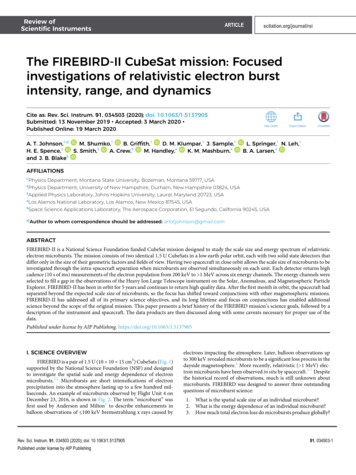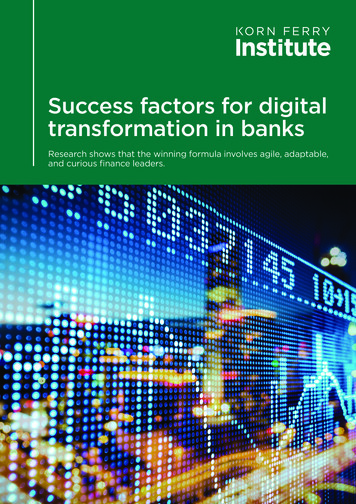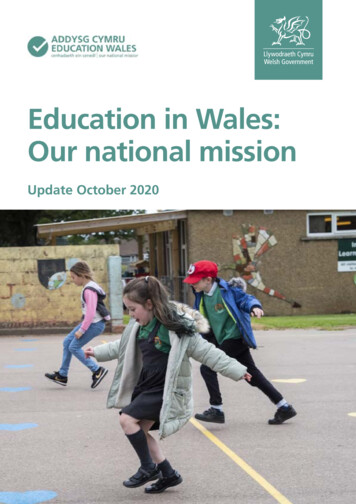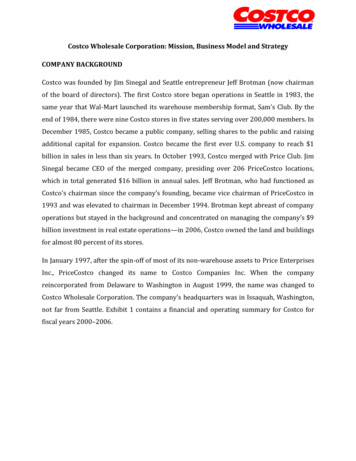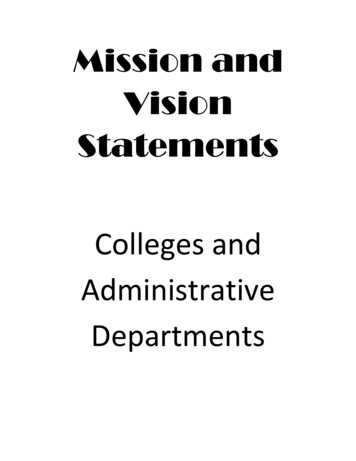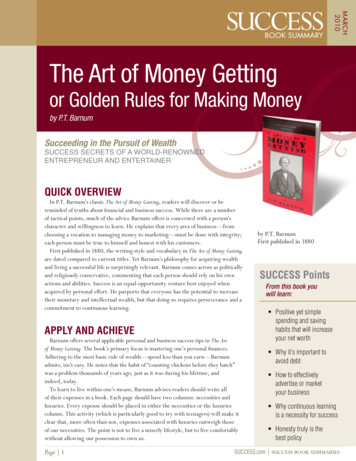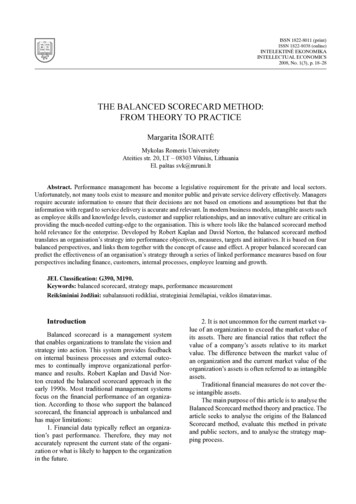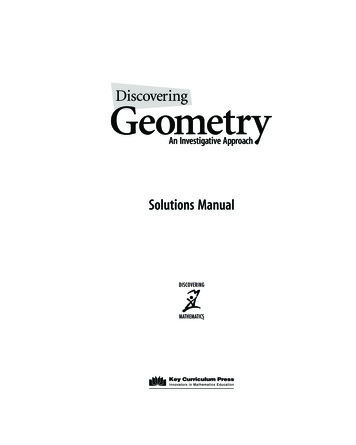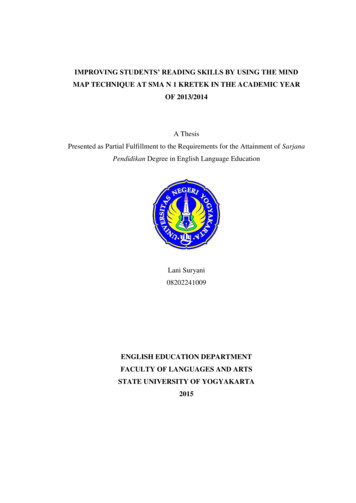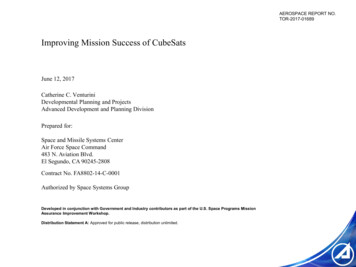
Transcription
AEROSPACE REPORT NO.TOR-2017-01689Improving Mission Success of CubeSatsJune 12, 2017Catherine C. VenturiniDevelopmental Planning and ProjectsAdvanced Development and Planning DivisionPrepared for:Space and Missile Systems CenterAir Force Space Command483 N. Aviation Blvd.El Segundo, CA 90245-2808Contract No. FA8802-14-C-0001Authorized by Space Systems GroupDeveloped in conjunction with Government and Industry contributors as part of the U.S. Space Programs MissionAssurance Improvement Workshop.Distribution Statement A: Approved for public release, distribution unlimited.
AbstractAs a concept, the CubeSat class of satellite is over 15 years old. The first were launched in 2003 and a few more in 2006.The numbers were noticeably greater in 2009 and have been increasing at a rapid pace ever since. However, if missionsuccess is defined as simply the degree to which the mission goals were achieved, then the mission success of this class ofsatellite has been low. To find out why, our mission assurance topic team interviewed CubeSat developers in academia,industry, and government-funded research centers. The information in this document comes from the interview responses toa common set of questions that were posed to guide, but not limit, these conversations. Those who have built and flownsatellites generously shared their processes, circumstances, results, and lessons learned, and everyone interviewed sharedtheir current processes and philosophies on design, testing, and mission assurance. While root cause was not determined formost on-orbit anomalies, the theories of what possibly went wrong were still useful, as were the lessons learned on whatcould have been improved during the development process. The responses were grouped into themes which concluded withsimple, actionable recommendations that we believe will improve the likelihood of mission success of future CubeSatdevelopment projects.i
AcknowledgmentsThis document has been produced as a collaborative effort of the Mission Assurance Improvement Workshop (MAIW). The forumwas organized to enhance mission assurance processes and supporting disciplines through collaboration between industry andgovernment across the U.S. Space Program community utilizing an issue-based approach. The process is to engage the appropriatesubject matter experts to share best practices across the community in order to produce valuable mission assurance guidancedocumentation.The document was created by multiple authors throughout the government and the aerospace industry. For their contentcontributions, the following contributing authors are acknowledged for making this collaborative effort possible:Barbara BraunDavid HinkleyCatherine VenturiniBob AndrewsGreg BergJeff ChristensenKim HicksMike TolmasoffAndrew WhitingTom WiedenbauerGary KushnerRick GebbieRenelito Delos SantosThe Aerospace CorporationThe Aerospace CorporationThe Aerospace CorporationBall Aerospace and Technologies CorporationThe Boeing CompanyThe Boeing CompanyThe Boeing CompanyThe Boeing CompanyThe Boeing CompanyHarris CorporationLockheed Martin CorporationMIT Lincoln LaboratorySSLA special thank you for co-leading this team and efforts to ensure completeness and quality of this document are extended to:Catherine VenturiniMike TolmasoffRenelito Delos SantosThe Aerospace CorporationThe Boeing CompanySSLii
The topic team would also like to acknowledge the contributions and feedback from the subject matter experts who reviewedthe product prior to publication:Ron DuphilyLynn FriesenLarry HarzstarkGail Johnson-RothElizabeth Klein-LebbinkArt McClellanCharles SwensonReuben RohrschneiderRyan NugentSteven PereiraAndrew RobertsonConor GalliganSue AlemanAndrew DemoKenneth LaBelJesse LeitnerMiquel MoeThe Aerospace CorporationThe Aerospace CorporationThe Aerospace CorporationThe Aerospace CorporationThe Aerospace CorporationThe Aerospace CorporationThe Aerospace CorporationBall Aerospace and Technologies CorporationCalifornia Polytechnic State University, San Luis ObispoJohns Hopkins University Applied Physics LaboratoryMillennium Space SystemsMIT Lincoln LaboratoryNASANASANASANASANASAiii
Improving Mission Success of CubeSatsMike Tolmasoff, The Boeing CompanyRenelito Delos Santos, SSLCatherine Venturini, The Aerospace CorporationJune 12, 2017U.S. SPACE PROGRAM MISSION ASSURANCE IMPROVEMENT WORKSHOPTHE BOEING COMPANY EL SEGUNDO, CA MAY 2–4, 2017
Outline IntroductionPresent state of affairsMethodology and processInterview statisticsThemesRecommendationsAcronyms and abbreviationsReferences and further readingU.S. SPACE PROGRAM MISSION ASSURANCE IMPROVEMENT WORKSHOPTHE BOEING COMPANY EL SEGUNDO, CA MAY 2–4, 20172
IntroductionU.S. SPACE PROGRAM MISSION ASSURANCE IMPROVEMENT WORKSHOPTHE BOEING COMPANY EL SEGUNDO, CA MAY 2–4, 20173
Problem Statement There has been an exponential increase in CubeSats launched since2003: 105 from 2003 through 2012, 79 in 2013, and 118 in 2014. Yetmission success rates average 45 percent and 77 percent betweenacademia and industry, respectively. Missions were deemed asuccess if the CubeSat operated on orbit for 60 days or longer [7]. As the importance of CubeSat payloads and missions increases, whataspects of mission assurance can significantly improve missionsuccess rates?U.S. SPACE PROGRAM MISSION ASSURANCE IMPROVEMENT WORKSHOPTHE BOEING COMPANY EL SEGUNDO, CA MAY 2–4, 20174
Intended Audience The target audience for this product consists of:– CubeSat designers and developers (academia, industry)– CubeSat product suppliers (hardware, software)– CubeSat customers (government, others) This product intended to address the needs of producers andconsumers– CubeSat designers, developers, and suppliers will use this productto improve their design and manufacturing processes– CubeSat customers will use this product to improve theirrequirements and statement of work documentationU.S. SPACE PROGRAM MISSION ASSURANCE IMPROVEMENT WORKSHOPTHE BOEING COMPANY EL SEGUNDO, CA MAY 2–4, 20175
Charter Brought a colloquium together to review CubeSat design andmanufacturing processes across industry, academia, andgovernment suppliers to identify best practicesInterviewed leading CubeSat suppliers from industry, academia, andgovernment to understand approaches taken to increase probability ofmission success, where mission success is defined as theachievement of desired mission performance over intended design lifeIdentified important areas (e.g., parts/qualification, design process,etc.) that CubeSat providers have focused on to improve probability ofmission successU.S. SPACE PROGRAM MISSION ASSURANCE IMPROVEMENT WORKSHOPTHE BOEING COMPANY EL SEGUNDO, CA MAY 2–4, 20176
Product Overview This study was made possible by the dedication of the MAIW steering andprogram committees and the hard work of the team comprising engineeringprofessionals from government, industry, and academiaThe “Present State of Affairs” section highlights the growth of CubeSatapplications and underscores the need “to move the needle” towardsimproving mission successThe “Methodology and Process” section thoroughly explains how our workwas performedThe “Interview Statistics” section highlights data gathered from the interviewsThe “Themes” section provides a comprehensive summary of the interviewsconducted and observations shared from the community that was interviewedThe “Recommendations” section describes the set of eight actionablerecommendations that we believe will help improve CubeSat mission successThe “References and Further Reading” section lists documents referenced inthe report and related documents compiled by the teamU.S. SPACE PROGRAM MISSION ASSURANCE IMPROVEMENT WORKSHOPTHE BOEING COMPANY EL SEGUNDO, CA MAY 2–4, 20177
Recommendation Summary The recommendations and rationale are on pages 68 through 84The eight recommendations are actionable and time-phased to aprogram lifecycle from authorization to proceed through delivery tolaunchEach recommendation can be implemented individuallyEach recommendation is scalable– High-risk-tolerant programs can implement a recommendation in asimple, low-side-compliant manner– Risk-adverse programs can implement a recommendation morerigorouslyThe recommendations are invariant to CubeSat sizeU.S. SPACE PROGRAM MISSION ASSURANCE IMPROVEMENT WORKSHOPTHE BOEING COMPANY EL SEGUNDO, CA MAY 2–4, 20178
Future Topic Areas Related to this Study Assess the value of implementing the study recommendationsUpdate interview questions to determine whether organizations areimplementing the study recommendations and what the impact hasbeen to their programs and missionsAssess the evolution of manufacturing towards large constellationsand how organizations implement processes to ensure missionsuccessEvaluate the CubeSat supply chain and what processes are beingused to qualify parts and subsystems, including interviewingsuppliersEvaluate utility and feasibility of shared-use facilities for integration,verification, and test (IV&T)U.S. SPACE PROGRAM MISSION ASSURANCE IMPROVEMENT WORKSHOPTHE BOEING COMPANY EL SEGUNDO, CA MAY 2–4, 20179
Present State of AffairsU.S. SPACE PROGRAM MISSION ASSURANCE IMPROVEMENT WORKSHOPTHE BOEING COMPANY EL SEGUNDO, CA MAY 2–4, 201710
Background CubeSats are generally defined by the standard of acube 10 centimeters (cm) x 10 cm x 10 cm(referred to as 1U) on each side, weighingapproximately 1.33 kilograms (kg) and having1 watt (W) of powerPicosatellite0.1–1 kgFrom this baseline, one can extend the sizeto a 10 cm x 10 cm x 20 cm (referred to as 2U)and 10 cm x 10 cm x 30 cm (referred to as 3U)form factor and largerThe standard was originally developed in thelate 1990s as a joint effort between CaliforniaPolytechnic State University, San Luis Obispo(Cal Poly) and Stanford University for theacademic community [13][14]Cal Poly and Stanford University developedthe Poly-Picosatellite Orbital Deployer(P-POD) launch dispenser standard to providea low-cost solution to develop and safely launchCubeSatsThe P-POD has a tubular design that can hold up to10 cm x 10 cm x 34 cm of deployable hardwareNanosatellite1–10 kgMicrosatellite10–100 kgU.S. SPACE PROGRAM MISSION ASSURANCE IMPROVEMENT WORKSHOPTHE BOEING COMPANY EL SEGUNDO, CA MAY 2–4, 2017Minisatellite100–500 kg11
CubeSats Launched from 2000 through 2016 The breakout year for CubeSats was 2013, which saw a fourfold increase in CubeSatlaunches [5]The increase in launch opportunitiessince 2013 is from:– Additional rideshareopportunities on U.S. launchvehicles– International Space Station(ISS) launches– Foreign launch opportunitiesCubeSat launches in 2016decreased due to launch failuresand delays [4]New entrant launch vehicles arein development that will expandoptions for access to space [4]Data Source: M. Swartwout CubeSat Database at Saint Louis University [4]U.S. SPACE PROGRAM MISSION ASSURANCE IMPROVEMENT WORKSHOPTHE BOEING COMPANY EL SEGUNDO, CA MAY 2–4, 201712
Commercial missions have been dominantin recent years, with private funding enablingmany new startup companies, e.g.,Planet Labs Inc. [8] Academia continues to have strongeducational component for training futureworkforce but also for conducting sciencemissions with funding from the NationalScience Foundation (NSF), Air ForceResearch Laboratory (AFRL), and theNational Aeronautics and SpaceAdministration (NASA) [9][10] Government interest has grown to includeoperational missions, including experimentsand technical demonstrations that provide animportant role in technology maturation [10]U.S. SPACE PROGRAM MISSION ASSURANCE IMPROVEMENT WORKSHOPTHE BOEING COMPANY EL SEGUNDO, CA MAY 2–4, 2017Courtesy of NASA Courtesy of NASACubeSats Launched from 2000 through 2016 (cont.)13
Methodology and ProcessU.S. SPACE PROGRAM MISSION ASSURANCE IMPROVEMENT WORKSHOPTHE BOEING COMPANY EL SEGUNDO, CA MAY 2–4, 201714
Methodology and Process Overview Research preparation– Literature search– Questionnaire development– Wish list of organizations to interview– Dry-run interviews to improve interviewing skills and refine questionnaireInterview process– Contact organizations and schedule interviews– Conduct interviews and generate interview summariesAnalysis process– Analyze data, identify themes, and formulate recommendationsProduct generation– Initial product– Subject matter expert review– Final productU.S. SPACE PROGRAM MISSION ASSURANCE IMPROVEMENT WORKSHOPTHE BOEING COMPANY EL SEGUNDO, CA MAY 2–4, 201715
Research Preparation Literature search– Goal: To ensure that mini-topic will not be replicating existing research– Result: No existing research found on mini-topicQuestionnaire development– Questions were intentionally open-ended to stimulate conversation duringthe actual interview– Team focused on obtaining qualitative data in seven major focus areas:1. Organizational experience with CubeSats2. Teams and turnover3. Customer expectations and risk tolerance4. Reviews5. Analyses and tests6. Most and least important tests or processes7. Organization's mission assurance philosophyU.S. SPACE PROGRAM MISSION ASSURANCE IMPROVEMENT WORKSHOPTHE BOEING COMPANY EL SEGUNDO, CA MAY 2–4, 201716
Research Preparation (cont.) Wish list of organizations to interview– 57 organizations identifiedDry-run interviews– Goal: To improve team interviewing skills and refine questionnaire– Result: Two dry-runs conducted, lessons learned debriefs held, andquestionnaire iteratedFinal questionnaire– The following pages present the final questionnaire that was used duringactual interviews– Questionnaire contains three main sections:1. Interview questions2. Reference list of analyses3. Reference list of testsU.S. SPACE PROGRAM MISSION ASSURANCE IMPROVEMENT WORKSHOPTHE BOEING COMPANY EL SEGUNDO, CA MAY 2–4, 201717
Final Questionnaire – Interview Questions1How many CubeSats has your organization built? Out of those built, how many have flown? Were themissions successful, where mission success is defined as achievement of the desired missionperformance over the intended design life?2 Describe one or more of your recent CubeSat missions. Was it successful? What do you think contributedmost to its success? If not successful, what would you do differently?3 What is the experience level of your team (e.g., recent college graduates, senior engineers, or amixture)?4 Do the team members change often or are the team members consistent for long periods of time?5 What were the customer expectations and risk-tolerance level (low, medium, high)? Did their expectationschange with time?6 Please list the major reviews that occurred for the project (e.g., preliminary design review [PDR], criticaldesign review [CDR], etc.). Did your customer participate in these reviews? Did you have independentreviewers participating?7 Before you approve a detailed design (mechanical, electrical, or software), do you perform an independentpeer review?8 What performance analyses were done (e.g., thermal simulation, power budget, radio frequency [RF] linkbudget)? What tests were done (e.g., thermal cycling, deployment testing)? See analyses and test listsbelow for reference.9 What test or process do you consider essential to CubeSat success (i.e., “if you only could do one test,which one would you do”)? What would be the second most important test/process? What test or processwould you eliminate if you could? What did you think was not value-added?10 What is your organization’s “philosophy” on mission assurance?U.S. SPACE PROGRAM MISSION ASSURANCE IMPROVEMENT WORKSHOPTHE BOEING COMPANY EL SEGUNDO, CA MAY 2–4, 201718
Final Questionnaire – Reference List of Analyses RF power marginPhase noisePointing/stability (assumes activecontrol)Power budget (energy balance)Mass propertiesClearance of deployments (assumesdeployable appendages)Thermal (external environmentalmodelling and internal effects)Finite element modelingVentingMechanical stressForce/torque margin (assumesdeployable appendages) Electrostatic discharge/internalelectrostatic discharge (ESD/iESD)Electromagnetic interference/electromagnetic compatibility (EMI/EMC )Single event effects/single event upsets(SEEs/SEUs)RadiationContaminationFailure modes effects analysis (FMEA )ReliabilityElectrical stressWorst-case circuit analysisSoftware throughputSoftware timingU.S. SPACE PROGRAM MISSION ASSURANCE IMPROVEMENT WORKSHOPTHE BOEING COMPANY EL SEGUNDO, CA MAY 2–4, 201719
Final Questionnaire – Reference List of Tests Thermal cycle testingThermal vacuum testingThermal balance testingRandom vibration testingAcoustic testingSine sweep (often done before andafter random vibration)Strength testing (sine burst, sinevibration, or other?)Modal survey testingShock testingEMI/EMC testingAbbreviated/full functional testingDay-in-the-life and week-in-the-lifetestingRF compatibility testing (factory and/orlaunch base) Command testing (checking commandsagainst the vehicle—sometimes done bytracking commands throughout thetesting sequence)End-to-end testing (involves the groundsystem and the end user)Deployment testing (including first-motiontesting)Mass properties (including spin balance)Fit checks (to the deployer in this case)Subsystem tests, e.g., star tracker,software, attitude determination andcontrol subsystem (ADCS) magnetictests, continuity tests on solar panels,antenna patterns, battery testingMission operations rehearsalU.S. SPACE PROGRAM MISSION ASSURANCE IMPROVEMENT WORKSHOPTHE BOEING COMPANY EL SEGUNDO, CA MAY 2–4, 201720
Interview Process Sub-divided topic team into four interview teams Final interview summary generated for each interview which passedmultiple peer reviews– Each interview team was responsible for: Initiating contact with organizations Scheduling and conducting interviews Taking interview notes and generating interview summaries– Individual roles assigned within interview sub-teams Lead interviewer, lead data analyst, and interview scribes– Multiple peer reviews ensured that the interview summary was both accurateand consistent with what was discussed during the interview Peer-reviewed and approved by greater topic team Peer-reviewed and approved by interviewed organizationU.S. SPACE PROGRAM MISSION ASSURANCE IMPROVEMENT WORKSHOPTHE BOEING COMPANY EL SEGUNDO, CA MAY 2–4, 201721
Contacting Organizations A communications package was developed to aid in reaching out toorganizations– The mini-topic, "Improving the Mission Success of CubeSats," is looking togather best practices and lessons learned from past and present CubeSatmissions that will benefit the entire community– We will not ask, nor do we want, any proprietary information The topic team comprises members from The Aerospace Corporation,academia, and industry None of the data will be released outside of the topic team– The aggregate data and analysis from the interviews will be available in apublicly releasable report Organizations will have the opportunity to review more detailed datafrom the interviewsFinal questionnaire was sent to organizations the week of theirinterviewsU.S. SPACE PROGRAM MISSION ASSURANCE IMPROVEMENT WORKSHOPTHE BOEING COMPANY EL SEGUNDO, CA MAY 2–4, 201722
Organizations InterviewedAcademia (10)Industry (5)Government/FFRDC/UARC (8)California Polytechnic StateUniversityAtmospheric & SpaceThe Aerospace CorporationTechnology ResearchAssociates, LLC (ASTRA)Georgia Institute of Technology Blue Canyon Technologies Air Force Research LaboratoryMassachusetts Institute ofThe Boeing CompanyMassachusetts Institute ofTechnologyTechnology Lincoln LaboratoryMontana State UniversityMillennium Space Systems NASA Ames Research CenterSaint Louis UniversityPlanetary ResourcesNASA Goddard Space Flight CenterUniversity of MichiganNASA Wallops Flight FacilityUniversity of SouthernSpace and Naval Warfare SystemsCaliforniaCommandUnited States Naval AcademySpace Dynamics LaboratoryU.S. Air Force AcademyUtah State University*Two organizations declined participation in the study and 32 organizations were not interviewed due to time constraintsTotal Participating Organizations: 23FFRDC Federally Funded Research and Development CenterUARC University-Affiliated Research CenterU.S. SPACE PROGRAM MISSION ASSURANCE IMPROVEMENT WORKSHOPTHE BOEING COMPANY EL SEGUNDO, CA MAY 2–4, 201723
Data Analysis Core dataset composed of all the interview notes and the interviewsummaries– 415 pages of interview data were mined Identified common themes and theme categories across interviews Developed recommendations by analyzing themes and themecategories– 40 common themes– 8 theme categories– 8 recommendations on how to improve mission success of CubeSatsU.S. SPACE PROGRAM MISSION ASSURANCE IMPROVEMENT WORKSHOPTHE BOEING COMPANY EL SEGUNDO, CA MAY 2–4, 201724
Product Generation Initial product– Topic team members took ownership over major sections:Product SectionIntroductionPresent State of AffairsMethodology and ProcessInterview StatisticsThemesRecommendationsReferences and Further Reading Subject matter expert review Final productSection LeadMike TolmasoffCatherine VenturiniRenelito Delos SantosGreg BergBarbara Braun, David Hinkley, and Bob AndrewsGary KushnerCatherine Venturini– 17 subject matter experts reviewed the draft product– 190 actionable comments were provided– Topic team adjudicated all actionable comments from subject matter experts andupdated the productU.S. SPACE PROGRAM MISSION ASSURANCE IMPROVEMENT WORKSHOPTHE BOEING COMPANY EL SEGUNDO, CA MAY 2–4, 201725
Interview StatisticsU.S. SPACE PROGRAM MISSION ASSURANCE IMPROVEMENT WORKSHOPTHE BOEING COMPANY EL SEGUNDO, CA MAY 2–4, 201726
Interview Statistics Introduction The following pages summarize statistical analyses based on answers givenduring the 23 interviews held with academia, industry, and governmentagencies– The data is primarily from the interviews, with minor additions from online sources– “Lessons learned” were volunteered by the interviewees. Some organizations wereless forthcoming than others with regard to identifying and discussing failures.– Both quantitative and qualitative data was obtained and assessed– Responses to the qualitative questions often included discussions that addressedon-orbit anomalies and potential corrective actions– For purposes of this assessment, the satellites were segregated into two size groups: Group 1 1U (1.33 kg) to 27U (36 kg) Picosats/Nanosats Group 2 27U to 200 kg Microsats/Smallsats– The development, launch, and on-orbit experiences for Group 1 spanned a timeframe from 2002 to 2016. The Smallsats in Group 2 include programs from the 1980sand 1990sU.S. SPACE PROGRAM MISSION ASSURANCE IMPROVEMENT WORKSHOPTHE BOEING COMPANY EL SEGUNDO, CA MAY 2–4, 201727
Interview Statistics – Basic Data Set Satellites built and flown by respondents250200Built or in work 1U - 27U size200Built or in work 27U size150Launched 1U to 27U sizeLaunched 27U size100765004237Launch failure 1U to 27U size180Launch failure 27U sizeU.S. SPACE PROGRAM MISSION ASSURANCE IMPROVEMENT WORKSHOPTHE BOEING COMPANY EL SEGUNDO, CA MAY 2–4, 201728
Mission Status by Size Respondent assessments of mission success for satellites thatachieved orbit 27U Size1U – 27U Size5%5%Dead on arrival (DOA)(no contact)10%8%Early loss20%65%Partial missionFull mission87%U.S. SPACE PROGRAM MISSION ASSURANCE IMPROVEMENT WORKSHOPTHE BOEING COMPANY EL SEGUNDO, CA MAY 2–4, 201729
Comparison to Related CubeSat ResearchDr. Swartwout’s database:288 CubeSats launched [6]MAIW interviews: 94Picosats/Nanosats launchedLaunchLaunch FailuresfailuresDOA19%4%8%53%16% lossEarly LossPartial missionMission1%10%14%17%22%missionFull MissionPrelaunchUnknownUnknown26%10%Rough correlation exists for launch failures and early loss categoriesMany more DOA observed in larger datasetMAIW interviewees appear to have more partial and full successes, possibly due to theseorganizations having more experience with lessons learned from multiple missionsU.S. SPACE PROGRAM MISSION ASSURANCE IMPROVEMENT WORKSHOPTHE BOEING COMPANY EL SEGUNDO, CA MAY 2–4, 201730
27 Anomalies Were Discussed During Interviews Respondents described anomaliesRespondents offered opinions on root cause– Each of the 27 has one or more contributors– Note that more ground testing could have identified some or allof the other issuesCouldwithmoreCould havehavebeenbeenavoidedavoidedwithgroundtesting testingmore tedtotoCommercialOff the(COTS)parts uncertaintiesShelf (COTS)parts . SPACE PROGRAM MISSION ASSURANCE IMPROVEMENT WORKSHOPTHE BOEING COMPANY EL SEGUNDO, CA MAY 2–4, 201731
ThemesU.S. SPACE PROGRAM MISSION ASSURANCE IMPROVEMENT WORKSHOPTHE BOEING COMPANY EL SEGUNDO, CA MAY 2–4, 201732
Themes Introduction During the course of the interviews, many themes emerged Most of the themes are broadly applicable to all missions regardless ofmission resources or success criteria; exceptions are notedTo preserve confidentiality, themes and observations are not attributedto specific companies or agenciesThemes were used to derive the recommendations that follow – These were concepts, practices, and observations made by theinterviewees which stood out, either due to their pertinence or theirrecurrence– Many of the themes were common across industry, academia, andgovernment Notable differences are mentioned on the following pagesU.S. SPACE PROGRAM MISSION ASSURANCE IMPROVEMENT WORKSHOPTHE BOEING COMPANY EL SEGUNDO, CA MAY 2–4, 201733
Theme 1: Setting the Purpose and Visionof the Mission Different agencies have different visions for CubeSats Industry observers must be careful when interpreting metrics ofsuccess– Some see them as educational tools for students– Some see them as “lab benches in space”– Some see them as capable platforms for simple or potentially complexmissions– CubeSats have relatively high failure rates in part because they are willingto take big risks– For academic institutions, student education is often the primary measureof mission success– A number of academic developers will launch regardless of readiness “We’d rather take a 5 percent chance of it working, than a 0 percentchance of it ever launching.”U.S. SPACE PROGRAM MISSION ASSURANCE IMPROVEMENT WORKSHOPTHE BOEING COMPANY EL SEGUNDO, CA MAY 2–4, 201734
Theme 1: Setting the Purpose and Visionof the Mission (cont.) Many organizations commented on the need for missions to beproperly scoped and resourced from the start– Many interviewees commented on the negative implications of “scopecreep” One interviewee discussed how a simple-seeming science change to amission led to redesign of the electronics board, noting, “Little decisionsearly on make a big impact at the end.” Another commented, “At first, we had very simple expectations. Then asthe requirements changed, we got in over our heads.”– Interviewees recommended establishing (and defending) a minimumbaseline mission, and also having a de-scope plan in place shouldcircumstances require itU.S. SPACE PROGRAM MISSION ASSURANCE IMPROVEMENT WORKSHOPTHE BOEING COMPANY EL SEGUNDO, CA MAY 2–4, 201735
Theme 1: Setting the Purpose and Visionof the Mission (cont.)Many organizations commented on the need for missions to beproperly scoped and resourced from the start (cont.)– Several interviewees encountered mismatches between funding/resourcesand expectations: “Make sure the financials match the mission up front.” Sometimes the customer had higher expectations of the project than thefunding could support Sometimes the developer was overly optimistic in cost estimation (thisis one situation where a de-scope plan can help)– Two agencies from industry identified the need for a “pathfinder”demonstration to validate new bus designs prior to production ofoperational vehicles “The customer should have recognized that without a pathfinder flight ofan ‘empty bus’ that there were too many new things on the first flight.”U.S. SPACE PROGRAM MISSION ASSURANCE IMPROVEMENT WORKSHOPTHE BOEING COMPANY EL SEGUNDO, CA MAY 2–4, 201736
Theme 1: Setting the Purpose and Visionof the Mission (cont.) Many organizations commented on the need for missions to beproperly scoped and resourced from the start (cont.)– Two academic institutions credited their strong systems engineeringapproach—and extreme resistance to scope creep—for their missionsuccess “Limit complexity, and test extensively” Establish the purpose, success criteria, and expectations of the missionearly and oftenThere is a need to define upfront what mission success actuallymeans, and to communicate this to key stakeholders from thebeginning to the end of the program– See References [1] through [3] for a discussion of risk management, riskcommunication, and requirements flowdown approachesU.S. SPACE PROGRAM MISSION ASSURANCE IMPROVEMENT WORKSHOPTHE BOEING COMPANY EL SEGUNDO, CA MAY 2–4, 201737
Theme 2: Establishing the Program Structure Team makeup– Team size and composition varied among CubeSat developers and fromacademia to industry Academic institutions have the highest turnover, as students graduate– Many academic teams benefited from experienced leads and mentors From the limited interview data, it appears that the more experiencedthe mentor is, the greater the success rate is among academicinstitutions Many mentors came from industry and applied the lessons learned fromindustry to their academic programsU.S. SPACE PROGRAM MISSION ASSURANCE IMPROVEMENT WORKSHOPTHE BOEING COMPANY EL SEGUNDO, CA MAY 2–4, 201738
Theme 2: Establishing the Program Structure (cont.) Documentation rigor–
The target audience for this product consists of: - CubeSat designers and developers (academia, industry) - CubeSat product suppliers (hardware, software) - CubeSat customers (government, others) This product intended to address the needs of producers and consumers - CubeSat designers, developers, and suppliers will use this product to improve their design and manufacturing processes
